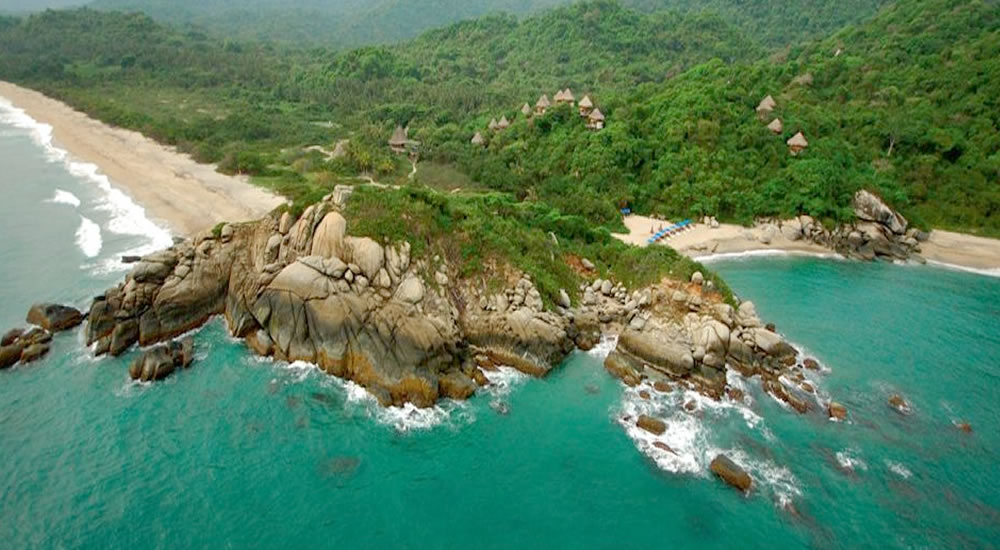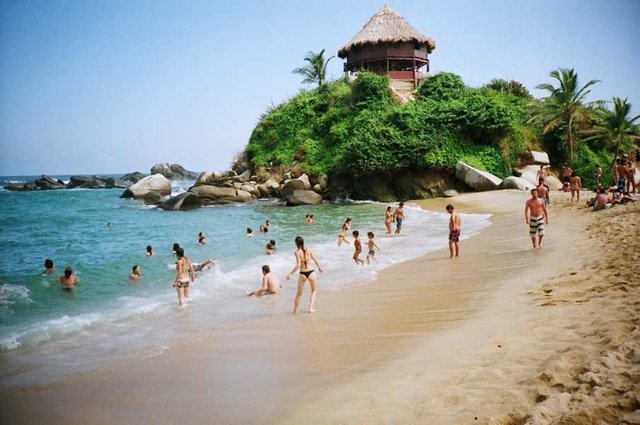TAYRONA NATURAL PARK
The foothills of the Sierra Nevada de Santa Marta, the highest coastal mountain in the world, sink into the sea like the fingers of a giant hand among which are bays and inlets of singular beauty: Chengue, Gayraca, Belt, Neguanje, Concha, Guachaquita, with its white sand beaches delimited by rocky atolls, mangroves, thickets or forests, and all bathed by the clear blue waters of the Caribbean Sea, are part of the many attractions offered by the Tayrona National Park.
For those looking for contemplation and rest, the Tayrona offers magnificent beaches and the relaxing panorama of an intensely blue sea. Those who are attracted by more exciting and varied activities can enjoy hiking, horseback riding, swimming, snorkelling and scuba diving. The Tayrona Park also has archaeological remains of an ancient city in the Tayrona village.
The Tayrona National Park is a habitat for a great diversity of fauna and flora species, among the former can be found groups of mammals and five species of felines have been listed for the area: Panthera onca (Jaguar), Leopardus pardalis (Ocelot), Leopardus wiedii (Tigrillo) and Puma yagouarondi (Yaguarundí), deer species such as Mazama americana and Mazama rufina, ñeques (Dasyprocta punctata), Zaínos (Tayassu tajacu), Guartinajas (Agouti paca) ), Anteaters (Tamandua mexicana and Myrmecophaga tridactyla), primates, rodents, bats, among others.
Ecosystems:
Among the terrestrial ecosystems that make up the Park are thorny scrub and dry, humid and cloudy forests. Marine-coastal ecosystems include coral formations, seagrass meadows, beaches, rocky coastlines, mangroves, algal grasslands, sandy bottoms, lagoons and mother-of-pearl.
Hydrography:
The Hydrography of the Park is made up of two drainage systems. The sea is formed by a group of small streams, streams and pipes that flow directly to the sea. In the western part the basins of the Bonito Gordo, Concha and Gayraca ravines remain dry for much of the year. Towards the east of Gayraca the flows increase gradually and become permanent. The Cinto, Cabo, La Boquita, San Lucas and Santa Rosa streams supply fresh water all year round. The continental drainage system is formed by the ravines that flow into the Piedras River.
Fauna:
The land area of the Park has more than 100 species of mammals, among them the tigrillo and deer, and birds as scarce as the condor, the solitary eagle and the white eagle. Hundreds of species of invertebrates inhabit the waters of the protected area, where fish are also abundant and marine mammals such as the dolphin are present.
Vegetation:
The occurrence of differences in rainfall in various sectors of the Park is one of the causes for the existence of a great diversity of flora. In the 12,000 hectares that comprise the terrestrial extension of the Park they develop from cactus to big trees. It should be noted that the coastal zone of the protected area presents the richest marine vegetation in the entire Colombian Caribbean with 31 different types of vegetation.
Ecotourism:
For its diversity of environments, both terrestrial and marine; For its archaeological remains; For its infrastructure and interpretation paths and for the great diversity of recreational, educational and cultural activities that can be developed in the Park, the Tayrona has a great ecotourism vocation.
Special attractions:
Besides being conservation objectives, the scenic beauties of the Tayrona Park are at the same time one of its main attractions. Ideal for tourism of sun, beach and diving are the Bays of Concha, Bonito Gordo, Gayraca, Neguanje, Playa del Muerto, Cañaveral, Arrecifes, Isla Aguja and Garnet. If what is preferred is ecological tourism or observation and knowledge of birds and forests, there are paths that from the marine part enter into the thick vegetation in the sectors of Neguanje, Cinto, Cañaveral-Arrecifes and the Naranjos. Other attractions in relation to the cultural aspect are the archaeological sites Pueblito or "Chairama" city, the Chairama Trail, the Chairama Archaeological Museum, the Nine Stones and Orange Paths.


Genial. Tienes un follow por este post.
Sería bueno que lo pongas en español para compartirlo en mi Facebook. Saludos.
It's beautiful!